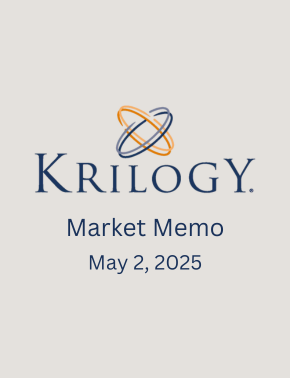Equity Markets:
The S&P 500 has rallied over the past week and a half. After finishing up 4.6% last week, the index has pushed higher by over 2% this week on the heels of positive earnings results and favorable movement on trade talks. The S&P 500 has rallied nearly 16% from its low of 4,835 on April 7. After seeing a 21% fall from the previous high, the market has returned to its “Pre-Liberation” levels. This is important to note because the market had been soft before the announcement of the new tariff policy. Since then, there has been some headway on policy, but much remains unresolved.
Over a third of S&P 500 companies have reported earnings. Thus far, 73% have exceeded earnings expectations and 64% have beaten revenue estimates1. These numbers are in line with historical averages, but an important factor from these earnings calls is that companies have portrayed a slower future outlook. Many companies have expressed concerns over the impacts of tariffs and see weaker demand as we move through the rest of the year. Downward earnings revisions are approaching the highest levels since the pandemic2.
The market has experienced a strong rally off the recent lows, and investors who could ride out the shorter-term volatility have been rewarded handsomely. The foundation of any portfolio should be 1. Aligned with an investor’s desired level of risk and 2. Have a strategic allocation that is optimal for reaching one’s long-term investment goals. We believe identifying an acceptable level of risk increases the probability of staying committed to a strategic allocation. Abandoning a strategy constructed for long-term investing could harm future returns. Taking on excessive market risk can lead to emotional selling and the challenging task of deciding when to invest back into the market. Market risk and rallies often happen quickly. An excellent example of this was the 9% rally from April 9.
After regaining the majority of the losses post “Liberation Day,” we believe the market will remain choppy. Broader economic risks remain, and investors should be wary of taking on extra risk beyond their strategic allocations. Staying disciplined during market rallies can be as challenging as staying disciplined during market lows. During improving sentiment and increasing prices, investors should reassess their current exposures to ensure they remain aligned with their long-term objectives.
Fixed Income Markets:
The labor market has continued its cool-off, and despite some inflationary concerns due to tariffs, we believe the policymakers will stay the course. This will likely lead to a range-bound rate market with the 10-year Treasury yield trading in the 4-4.5% range through the end of the year. Our long-term view of the fixed income market remains positive. We believe starting yields can provide investors with a diversified source of return, and are high enough to offer potential negative correlation if we experience a significant slowing in the economy and broader market drawdown. Credit spreads have loosened slightly over the past month, but remain at historically tight levels, and also believe investors are better served in higher-quality instruments.
Economic:
This week has been a busy one for economic data. Labor market reports have taken the forefront for us. The Job Openings and Labor Turnover Survey (JOLTS) was released on Tuesday. Job openings fell to 7.162 million, a six-month low, equating to 1.02 jobs available per unemployed worker3. This ratio has dropped significantly since the 2.02 reading in 2021. This is indicative of a cooler labor market. The ADP Private Payrolls report also came in soft. According to the report, private sector payrolls rose by 62,000, well below the Dow Jones consensus estimate of 120,000. Weekly unemployment claims were 241,000, an increase of 18,000 from the prior month and above the estimated 225,000. April’s Non-Farm Payrolls beat expectations and reported that the US economy created 177,000 jobs for the month. The unemployment rate remained unchanged at 4.2%.
The two other highlights for the week were the GDP and the PCE Report. First quarter GDP contracted 0.3% according to the advance estimate. This marks the first contraction since Q1 2022. While many look at the GDP report as an indicator of a recession, when taking a look beneath the hood, a significant detractor was the large increase in imports in the first quarter. The substantial increase was primarily due to companies front-loading their shipments in preparation for the tariff announcement on April 2. The March Core PCE Index rose more than expected and was up 2.6% from one year ago.
Going forward, we are paying close attention to the labor market. Nearly 70% of the US Economy is consumer-based, and we believe that as long as consumers can remain in a relatively healthy financial position with enough confidence in job security, they could be a driving force to push through an economic slowdown without experiencing a materially lower drawdown in the equity markets than we have already witnessed this year.
Sources:
1)FactSet Research, Inc.
2) Charles Schwab, Factset Data
https://x.com/JeffreyKleintop/status/1917949011488813323/photo/1
3)Advisor Perspectives
https://www.advisorperspectives.com/dshort/updates/2025/04/29/jolts-report-job-openings-march-2025
Important Disclosures:
Investment Advisory Services offered through Krilogy®, an SEC Registered Investment Advisor. Please review all prospectuses and Krilogy’s Form ADV 2A carefully prior to investing. This is neither an offer to sell nor a solicitation of an offer to buy the securities described herein. An offering is made only by a prospectus to individuals who meet minimum suitability requirements.
All expressions of opinion are subject to change. This information is distributed for educational purposes only, and it is not to be construed as an offer, solicitation, recommendation, or endorsement of any particular security, products, or services.
Diversification does not eliminate the risk of market loss. Investments involve risk and unless otherwise stated, are not guaranteed. Investors should understand the risks involved of owning investments, including interest rate risk, credit risk and market risk. Investment risks include loss of principal and fluctuating value. There is no guarantee an investing strategy will be successful. Past performance is not a guarantee of future results. Indices are not available for direct investment; therefore, their performance does not reflect the expenses associated with the management of an actual portfolio. The S&P data is provided by Standard & Poor’s Index Services Group.
Services and products offered through Krilogy® are not insured and may lose value. Be sure to first consult with a qualified financial advisor and/or tax professional before implementing any strategy discussed herein.




















